Urbanization, Nature, and Mental Health: A Public Health Perspective
VerifiedAdded on 2021/06/17
|20
|6320
|142
Essay
AI Summary
This essay delves into the critical relationship between nature and mental health, particularly within the context of increasing urbanization. It examines the benefits of exposure to natural environments, such as reduced stress levels, improved cognitive function, and enhanced overall well-being. The essay highlights the impact of urbanization on mental health, the role of environmental psychology, and the importance of incorporating green spaces into urban planning. Furthermore, it discusses the influence of income and materialistic tendencies on individuals' ability to access and benefit from natural surroundings. The essay references various studies and theories, including the attention-restoration theory, to support its arguments, emphasizing the need to understand and leverage the psychological benefits of nature to address mental health challenges in modern society.
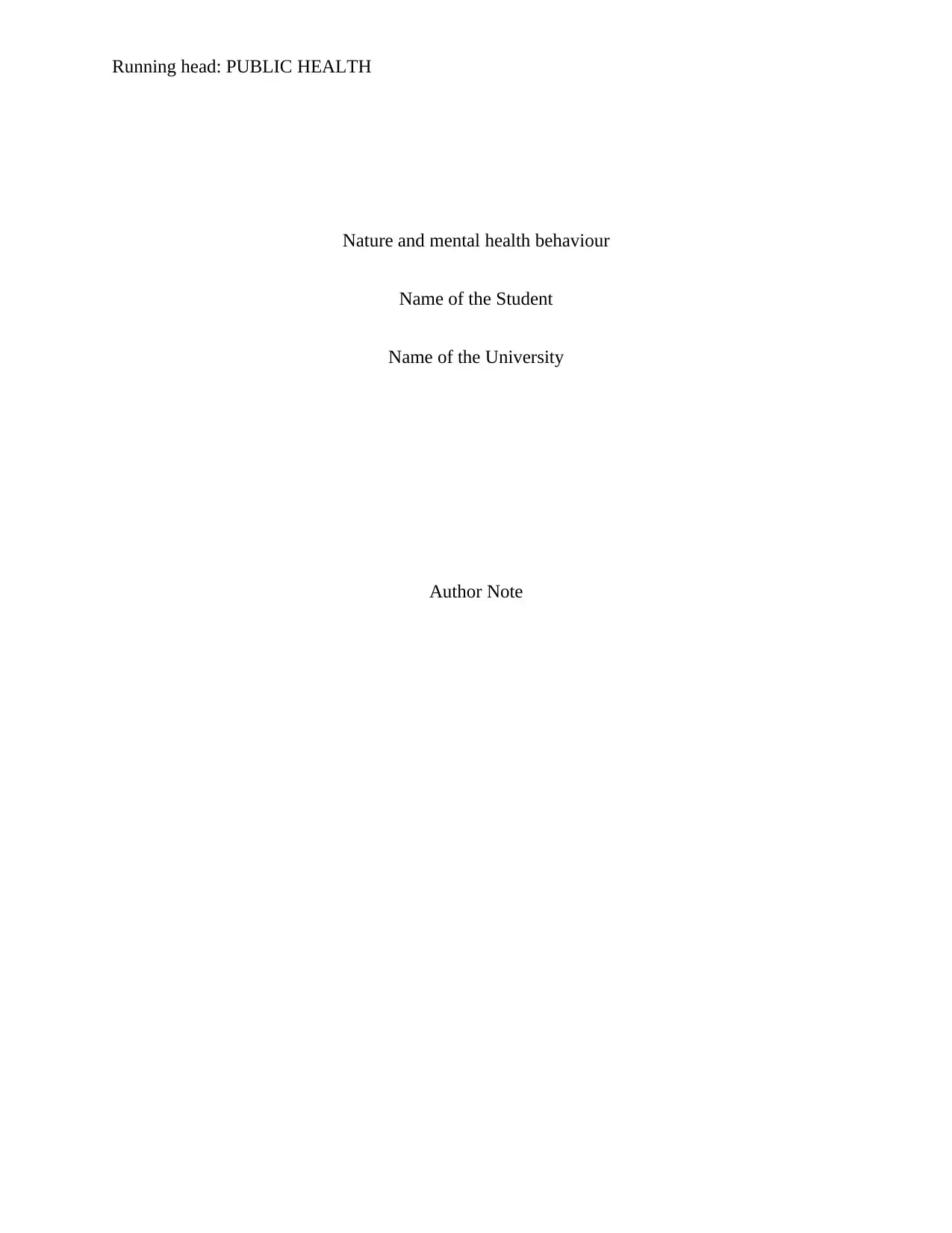
Running head: PUBLIC HEALTH
Nature and mental health behaviour
Name of the Student
Name of the University
Author Note
Nature and mental health behaviour
Name of the Student
Name of the University
Author Note
Paraphrase This Document
Need a fresh take? Get an instant paraphrase of this document with our AI Paraphraser
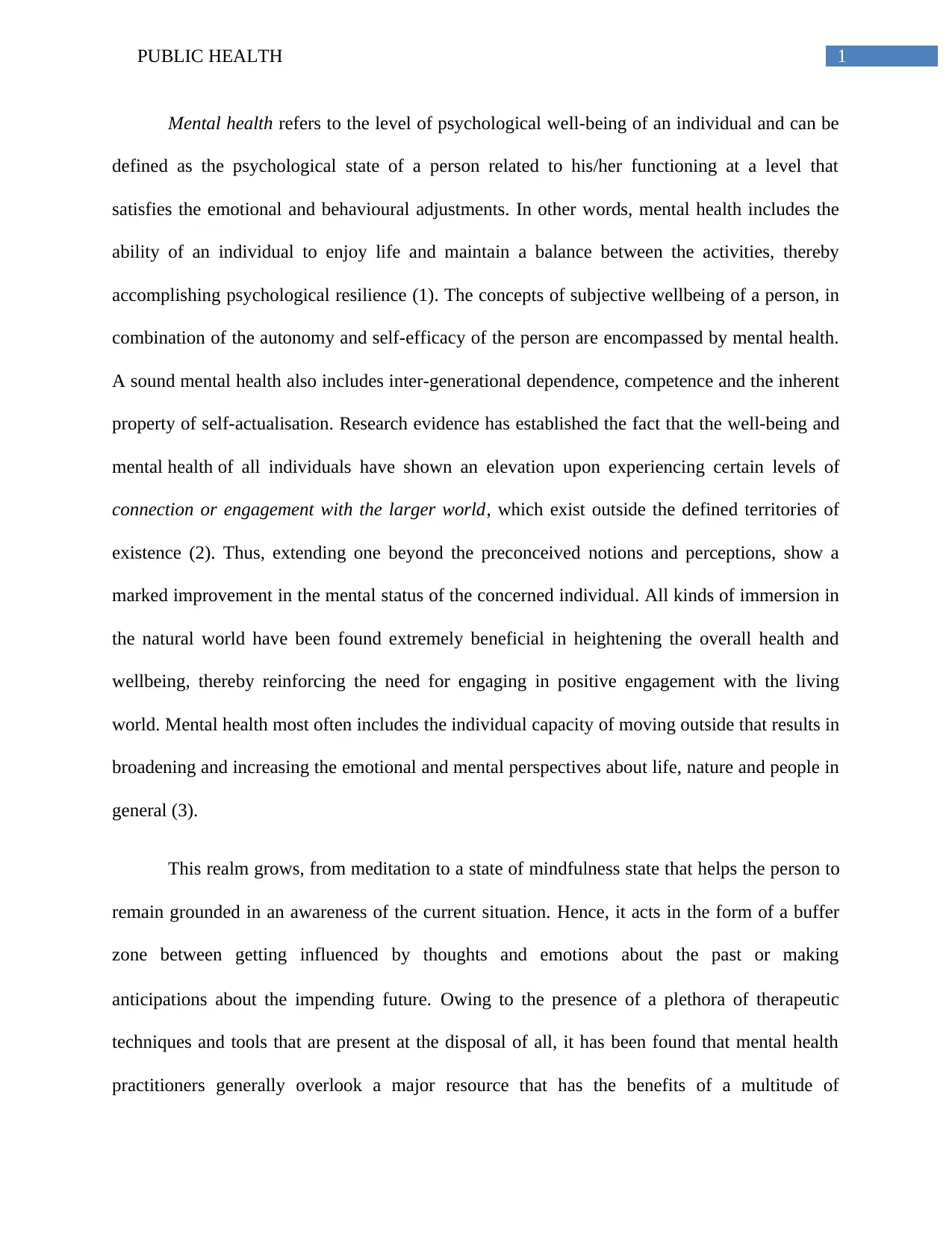
1PUBLIC HEALTH
Mental health refers to the level of psychological well-being of an individual and can be
defined as the psychological state of a person related to his/her functioning at a level that
satisfies the emotional and behavioural adjustments. In other words, mental health includes the
ability of an individual to enjoy life and maintain a balance between the activities, thereby
accomplishing psychological resilience (1). The concepts of subjective wellbeing of a person, in
combination of the autonomy and self-efficacy of the person are encompassed by mental health.
A sound mental health also includes inter-generational dependence, competence and the inherent
property of self-actualisation. Research evidence has established the fact that the well-being and
mental health of all individuals have shown an elevation upon experiencing certain levels of
connection or engagement with the larger world, which exist outside the defined territories of
existence (2). Thus, extending one beyond the preconceived notions and perceptions, show a
marked improvement in the mental status of the concerned individual. All kinds of immersion in
the natural world have been found extremely beneficial in heightening the overall health and
wellbeing, thereby reinforcing the need for engaging in positive engagement with the living
world. Mental health most often includes the individual capacity of moving outside that results in
broadening and increasing the emotional and mental perspectives about life, nature and people in
general (3).
This realm grows, from meditation to a state of mindfulness state that helps the person to
remain grounded in an awareness of the current situation. Hence, it acts in the form of a buffer
zone between getting influenced by thoughts and emotions about the past or making
anticipations about the impending future. Owing to the presence of a plethora of therapeutic
techniques and tools that are present at the disposal of all, it has been found that mental health
practitioners generally overlook a major resource that has the benefits of a multitude of
Mental health refers to the level of psychological well-being of an individual and can be
defined as the psychological state of a person related to his/her functioning at a level that
satisfies the emotional and behavioural adjustments. In other words, mental health includes the
ability of an individual to enjoy life and maintain a balance between the activities, thereby
accomplishing psychological resilience (1). The concepts of subjective wellbeing of a person, in
combination of the autonomy and self-efficacy of the person are encompassed by mental health.
A sound mental health also includes inter-generational dependence, competence and the inherent
property of self-actualisation. Research evidence has established the fact that the well-being and
mental health of all individuals have shown an elevation upon experiencing certain levels of
connection or engagement with the larger world, which exist outside the defined territories of
existence (2). Thus, extending one beyond the preconceived notions and perceptions, show a
marked improvement in the mental status of the concerned individual. All kinds of immersion in
the natural world have been found extremely beneficial in heightening the overall health and
wellbeing, thereby reinforcing the need for engaging in positive engagement with the living
world. Mental health most often includes the individual capacity of moving outside that results in
broadening and increasing the emotional and mental perspectives about life, nature and people in
general (3).
This realm grows, from meditation to a state of mindfulness state that helps the person to
remain grounded in an awareness of the current situation. Hence, it acts in the form of a buffer
zone between getting influenced by thoughts and emotions about the past or making
anticipations about the impending future. Owing to the presence of a plethora of therapeutic
techniques and tools that are present at the disposal of all, it has been found that mental health
practitioners generally overlook a major resource that has the benefits of a multitude of
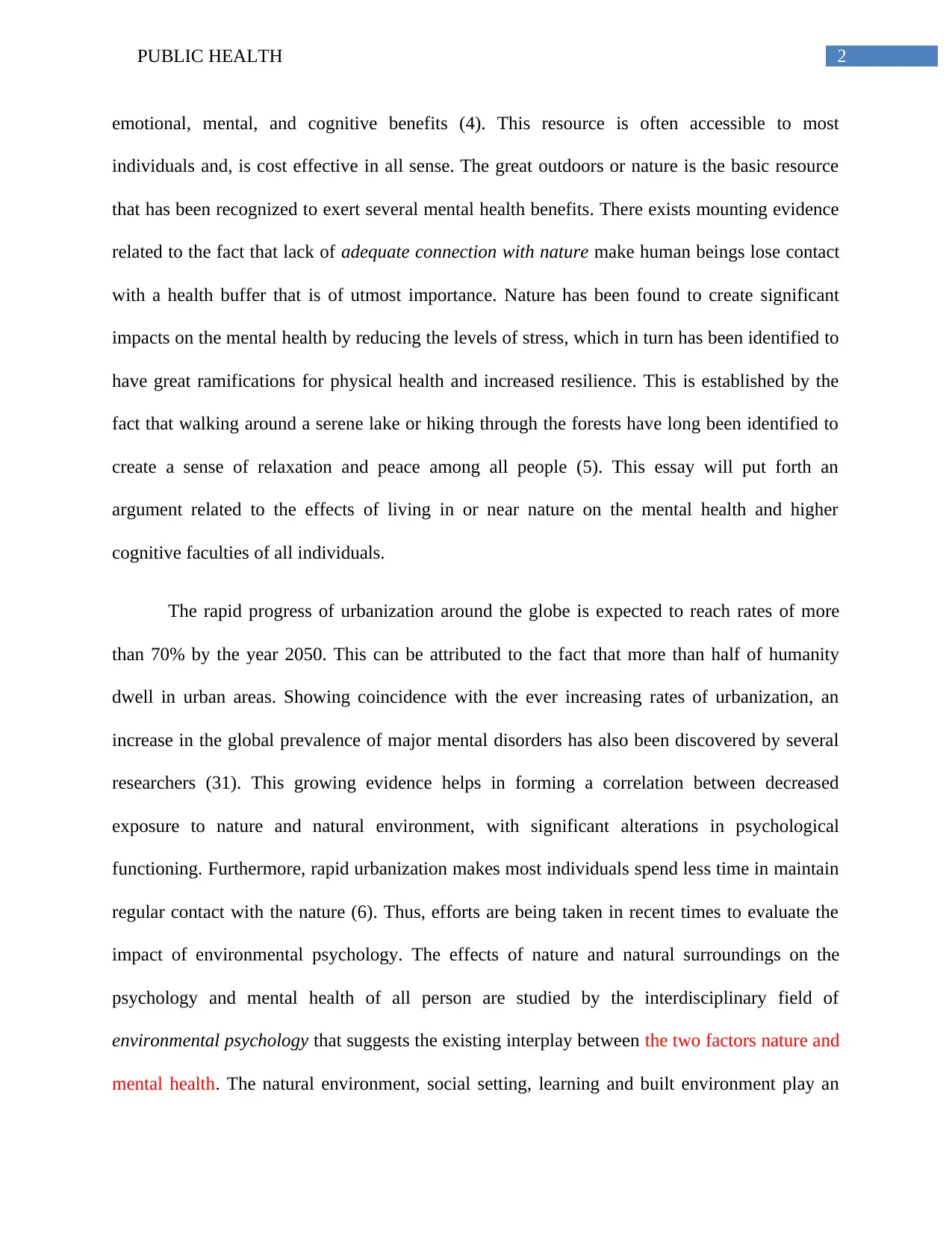
2PUBLIC HEALTH
emotional, mental, and cognitive benefits (4). This resource is often accessible to most
individuals and, is cost effective in all sense. The great outdoors or nature is the basic resource
that has been recognized to exert several mental health benefits. There exists mounting evidence
related to the fact that lack of adequate connection with nature make human beings lose contact
with a health buffer that is of utmost importance. Nature has been found to create significant
impacts on the mental health by reducing the levels of stress, which in turn has been identified to
have great ramifications for physical health and increased resilience. This is established by the
fact that walking around a serene lake or hiking through the forests have long been identified to
create a sense of relaxation and peace among all people (5). This essay will put forth an
argument related to the effects of living in or near nature on the mental health and higher
cognitive faculties of all individuals.
The rapid progress of urbanization around the globe is expected to reach rates of more
than 70% by the year 2050. This can be attributed to the fact that more than half of humanity
dwell in urban areas. Showing coincidence with the ever increasing rates of urbanization, an
increase in the global prevalence of major mental disorders has also been discovered by several
researchers (31). This growing evidence helps in forming a correlation between decreased
exposure to nature and natural environment, with significant alterations in psychological
functioning. Furthermore, rapid urbanization makes most individuals spend less time in maintain
regular contact with the nature (6). Thus, efforts are being taken in recent times to evaluate the
impact of environmental psychology. The effects of nature and natural surroundings on the
psychology and mental health of all person are studied by the interdisciplinary field of
environmental psychology that suggests the existing interplay between the two factors nature and
mental health. The natural environment, social setting, learning and built environment play an
emotional, mental, and cognitive benefits (4). This resource is often accessible to most
individuals and, is cost effective in all sense. The great outdoors or nature is the basic resource
that has been recognized to exert several mental health benefits. There exists mounting evidence
related to the fact that lack of adequate connection with nature make human beings lose contact
with a health buffer that is of utmost importance. Nature has been found to create significant
impacts on the mental health by reducing the levels of stress, which in turn has been identified to
have great ramifications for physical health and increased resilience. This is established by the
fact that walking around a serene lake or hiking through the forests have long been identified to
create a sense of relaxation and peace among all people (5). This essay will put forth an
argument related to the effects of living in or near nature on the mental health and higher
cognitive faculties of all individuals.
The rapid progress of urbanization around the globe is expected to reach rates of more
than 70% by the year 2050. This can be attributed to the fact that more than half of humanity
dwell in urban areas. Showing coincidence with the ever increasing rates of urbanization, an
increase in the global prevalence of major mental disorders has also been discovered by several
researchers (31). This growing evidence helps in forming a correlation between decreased
exposure to nature and natural environment, with significant alterations in psychological
functioning. Furthermore, rapid urbanization makes most individuals spend less time in maintain
regular contact with the nature (6). Thus, efforts are being taken in recent times to evaluate the
impact of environmental psychology. The effects of nature and natural surroundings on the
psychology and mental health of all person are studied by the interdisciplinary field of
environmental psychology that suggests the existing interplay between the two factors nature and
mental health. The natural environment, social setting, learning and built environment play an
⊘ This is a preview!⊘
Do you want full access?
Subscribe today to unlock all pages.

Trusted by 1+ million students worldwide
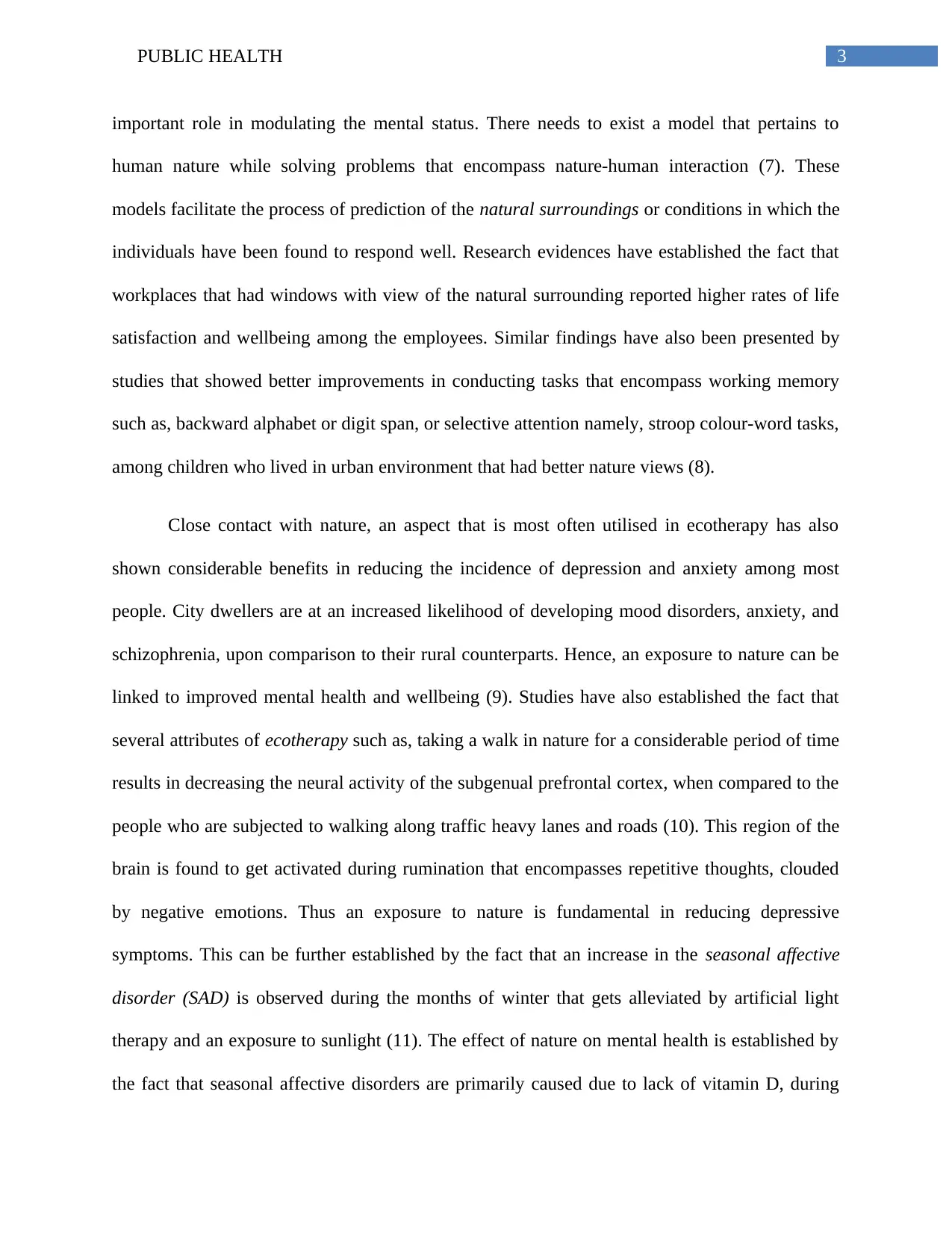
3PUBLIC HEALTH
important role in modulating the mental status. There needs to exist a model that pertains to
human nature while solving problems that encompass nature-human interaction (7). These
models facilitate the process of prediction of the natural surroundings or conditions in which the
individuals have been found to respond well. Research evidences have established the fact that
workplaces that had windows with view of the natural surrounding reported higher rates of life
satisfaction and wellbeing among the employees. Similar findings have also been presented by
studies that showed better improvements in conducting tasks that encompass working memory
such as, backward alphabet or digit span, or selective attention namely, stroop colour-word tasks,
among children who lived in urban environment that had better nature views (8).
Close contact with nature, an aspect that is most often utilised in ecotherapy has also
shown considerable benefits in reducing the incidence of depression and anxiety among most
people. City dwellers are at an increased likelihood of developing mood disorders, anxiety, and
schizophrenia, upon comparison to their rural counterparts. Hence, an exposure to nature can be
linked to improved mental health and wellbeing (9). Studies have also established the fact that
several attributes of ecotherapy such as, taking a walk in nature for a considerable period of time
results in decreasing the neural activity of the subgenual prefrontal cortex, when compared to the
people who are subjected to walking along traffic heavy lanes and roads (10). This region of the
brain is found to get activated during rumination that encompasses repetitive thoughts, clouded
by negative emotions. Thus an exposure to nature is fundamental in reducing depressive
symptoms. This can be further established by the fact that an increase in the seasonal affective
disorder (SAD) is observed during the months of winter that gets alleviated by artificial light
therapy and an exposure to sunlight (11). The effect of nature on mental health is established by
the fact that seasonal affective disorders are primarily caused due to lack of vitamin D, during
important role in modulating the mental status. There needs to exist a model that pertains to
human nature while solving problems that encompass nature-human interaction (7). These
models facilitate the process of prediction of the natural surroundings or conditions in which the
individuals have been found to respond well. Research evidences have established the fact that
workplaces that had windows with view of the natural surrounding reported higher rates of life
satisfaction and wellbeing among the employees. Similar findings have also been presented by
studies that showed better improvements in conducting tasks that encompass working memory
such as, backward alphabet or digit span, or selective attention namely, stroop colour-word tasks,
among children who lived in urban environment that had better nature views (8).
Close contact with nature, an aspect that is most often utilised in ecotherapy has also
shown considerable benefits in reducing the incidence of depression and anxiety among most
people. City dwellers are at an increased likelihood of developing mood disorders, anxiety, and
schizophrenia, upon comparison to their rural counterparts. Hence, an exposure to nature can be
linked to improved mental health and wellbeing (9). Studies have also established the fact that
several attributes of ecotherapy such as, taking a walk in nature for a considerable period of time
results in decreasing the neural activity of the subgenual prefrontal cortex, when compared to the
people who are subjected to walking along traffic heavy lanes and roads (10). This region of the
brain is found to get activated during rumination that encompasses repetitive thoughts, clouded
by negative emotions. Thus an exposure to nature is fundamental in reducing depressive
symptoms. This can be further established by the fact that an increase in the seasonal affective
disorder (SAD) is observed during the months of winter that gets alleviated by artificial light
therapy and an exposure to sunlight (11). The effect of nature on mental health is established by
the fact that seasonal affective disorders are primarily caused due to lack of vitamin D, during
Paraphrase This Document
Need a fresh take? Get an instant paraphrase of this document with our AI Paraphraser
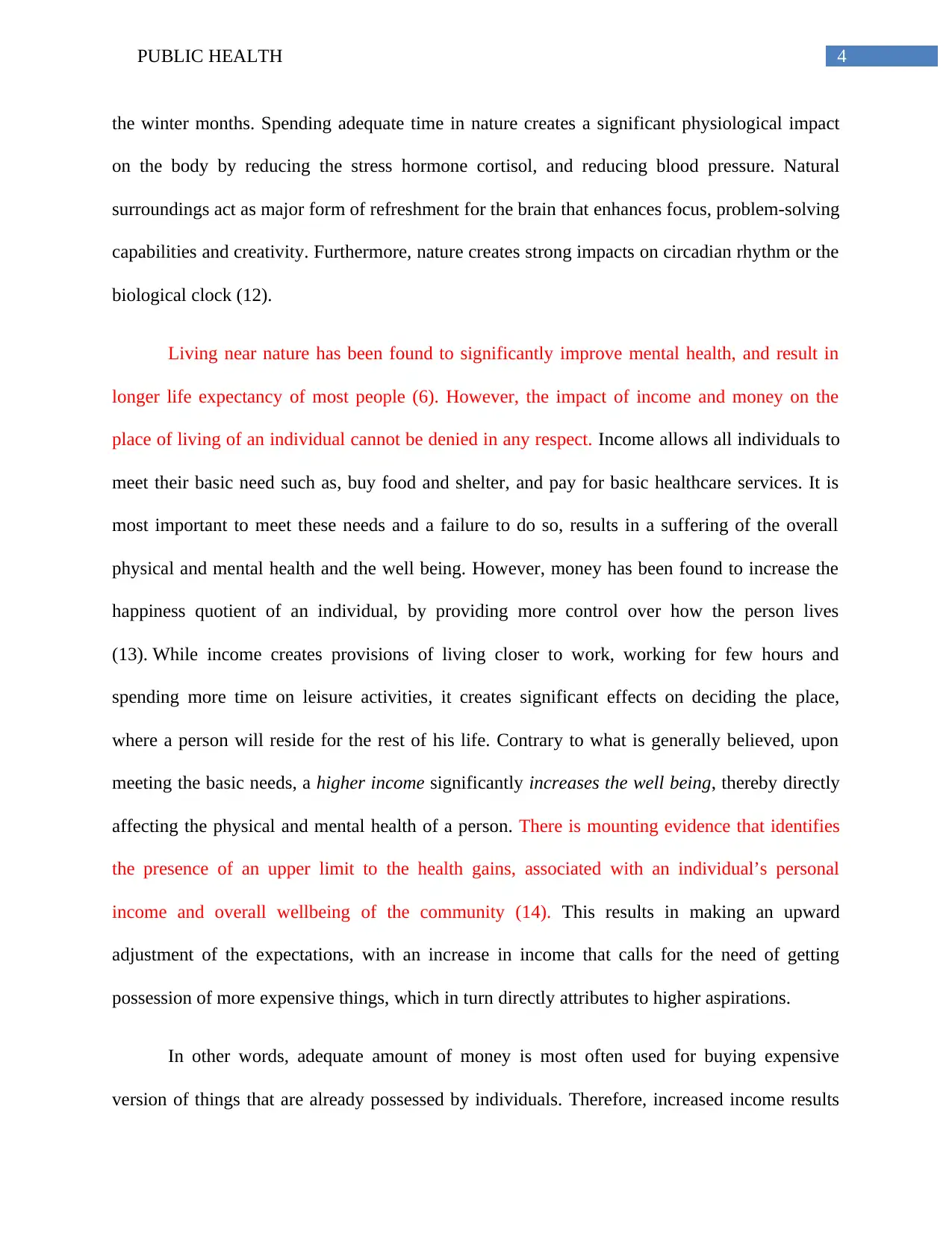
4PUBLIC HEALTH
the winter months. Spending adequate time in nature creates a significant physiological impact
on the body by reducing the stress hormone cortisol, and reducing blood pressure. Natural
surroundings act as major form of refreshment for the brain that enhances focus, problem-solving
capabilities and creativity. Furthermore, nature creates strong impacts on circadian rhythm or the
biological clock (12).
Living near nature has been found to significantly improve mental health, and result in
longer life expectancy of most people (6). However, the impact of income and money on the
place of living of an individual cannot be denied in any respect. Income allows all individuals to
meet their basic need such as, buy food and shelter, and pay for basic healthcare services. It is
most important to meet these needs and a failure to do so, results in a suffering of the overall
physical and mental health and the well being. However, money has been found to increase the
happiness quotient of an individual, by providing more control over how the person lives
(13). While income creates provisions of living closer to work, working for few hours and
spending more time on leisure activities, it creates significant effects on deciding the place,
where a person will reside for the rest of his life. Contrary to what is generally believed, upon
meeting the basic needs, a higher income significantly increases the well being, thereby directly
affecting the physical and mental health of a person. There is mounting evidence that identifies
the presence of an upper limit to the health gains, associated with an individual’s personal
income and overall wellbeing of the community (14). This results in making an upward
adjustment of the expectations, with an increase in income that calls for the need of getting
possession of more expensive things, which in turn directly attributes to higher aspirations.
In other words, adequate amount of money is most often used for buying expensive
version of things that are already possessed by individuals. Therefore, increased income results
the winter months. Spending adequate time in nature creates a significant physiological impact
on the body by reducing the stress hormone cortisol, and reducing blood pressure. Natural
surroundings act as major form of refreshment for the brain that enhances focus, problem-solving
capabilities and creativity. Furthermore, nature creates strong impacts on circadian rhythm or the
biological clock (12).
Living near nature has been found to significantly improve mental health, and result in
longer life expectancy of most people (6). However, the impact of income and money on the
place of living of an individual cannot be denied in any respect. Income allows all individuals to
meet their basic need such as, buy food and shelter, and pay for basic healthcare services. It is
most important to meet these needs and a failure to do so, results in a suffering of the overall
physical and mental health and the well being. However, money has been found to increase the
happiness quotient of an individual, by providing more control over how the person lives
(13). While income creates provisions of living closer to work, working for few hours and
spending more time on leisure activities, it creates significant effects on deciding the place,
where a person will reside for the rest of his life. Contrary to what is generally believed, upon
meeting the basic needs, a higher income significantly increases the well being, thereby directly
affecting the physical and mental health of a person. There is mounting evidence that identifies
the presence of an upper limit to the health gains, associated with an individual’s personal
income and overall wellbeing of the community (14). This results in making an upward
adjustment of the expectations, with an increase in income that calls for the need of getting
possession of more expensive things, which in turn directly attributes to higher aspirations.
In other words, adequate amount of money is most often used for buying expensive
version of things that are already possessed by individuals. Therefore, increased income results
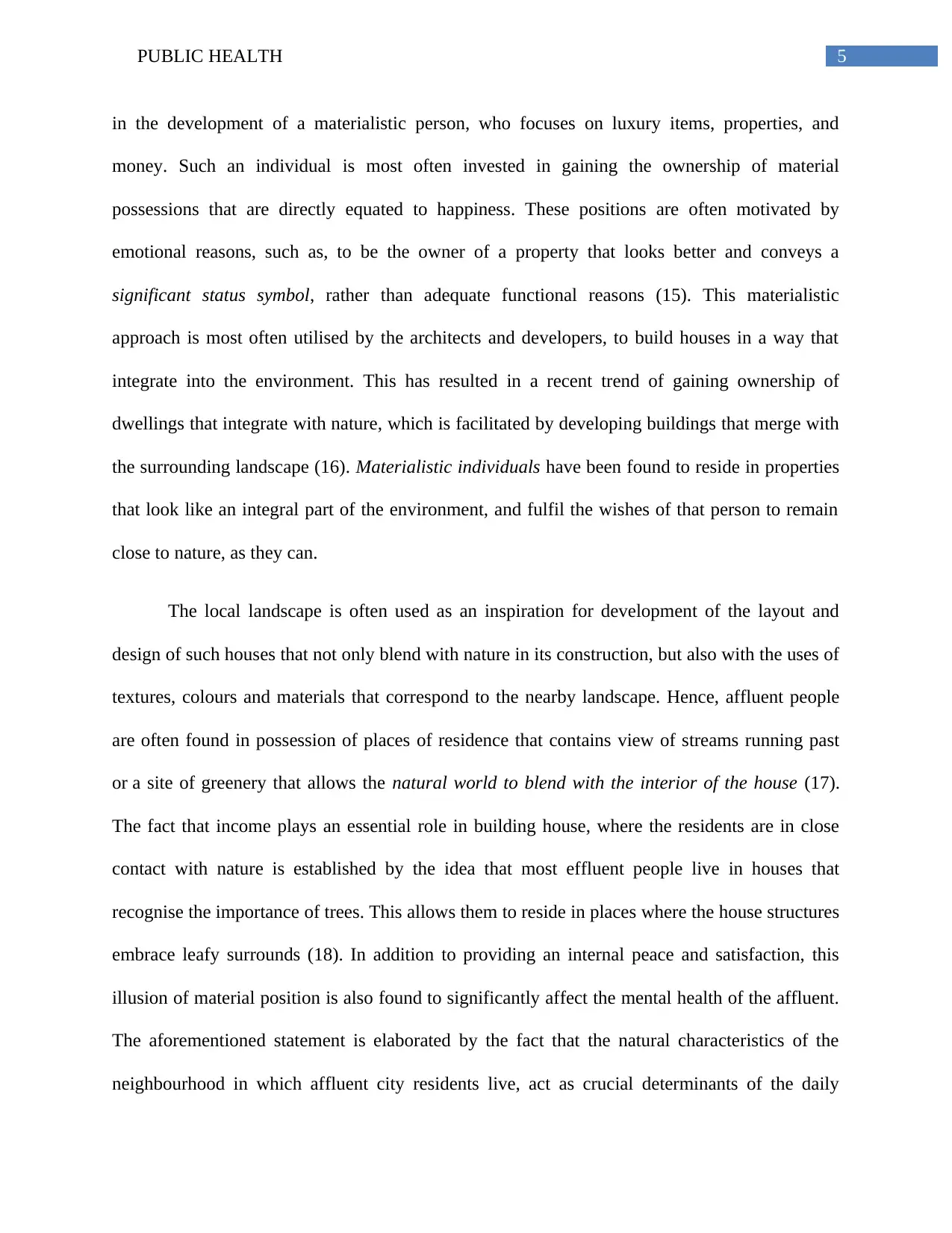
5PUBLIC HEALTH
in the development of a materialistic person, who focuses on luxury items, properties, and
money. Such an individual is most often invested in gaining the ownership of material
possessions that are directly equated to happiness. These positions are often motivated by
emotional reasons, such as, to be the owner of a property that looks better and conveys a
significant status symbol, rather than adequate functional reasons (15). This materialistic
approach is most often utilised by the architects and developers, to build houses in a way that
integrate into the environment. This has resulted in a recent trend of gaining ownership of
dwellings that integrate with nature, which is facilitated by developing buildings that merge with
the surrounding landscape (16). Materialistic individuals have been found to reside in properties
that look like an integral part of the environment, and fulfil the wishes of that person to remain
close to nature, as they can.
The local landscape is often used as an inspiration for development of the layout and
design of such houses that not only blend with nature in its construction, but also with the uses of
textures, colours and materials that correspond to the nearby landscape. Hence, affluent people
are often found in possession of places of residence that contains view of streams running past
or a site of greenery that allows the natural world to blend with the interior of the house (17).
The fact that income plays an essential role in building house, where the residents are in close
contact with nature is established by the idea that most effluent people live in houses that
recognise the importance of trees. This allows them to reside in places where the house structures
embrace leafy surrounds (18). In addition to providing an internal peace and satisfaction, this
illusion of material position is also found to significantly affect the mental health of the affluent.
The aforementioned statement is elaborated by the fact that the natural characteristics of the
neighbourhood in which affluent city residents live, act as crucial determinants of the daily
in the development of a materialistic person, who focuses on luxury items, properties, and
money. Such an individual is most often invested in gaining the ownership of material
possessions that are directly equated to happiness. These positions are often motivated by
emotional reasons, such as, to be the owner of a property that looks better and conveys a
significant status symbol, rather than adequate functional reasons (15). This materialistic
approach is most often utilised by the architects and developers, to build houses in a way that
integrate into the environment. This has resulted in a recent trend of gaining ownership of
dwellings that integrate with nature, which is facilitated by developing buildings that merge with
the surrounding landscape (16). Materialistic individuals have been found to reside in properties
that look like an integral part of the environment, and fulfil the wishes of that person to remain
close to nature, as they can.
The local landscape is often used as an inspiration for development of the layout and
design of such houses that not only blend with nature in its construction, but also with the uses of
textures, colours and materials that correspond to the nearby landscape. Hence, affluent people
are often found in possession of places of residence that contains view of streams running past
or a site of greenery that allows the natural world to blend with the interior of the house (17).
The fact that income plays an essential role in building house, where the residents are in close
contact with nature is established by the idea that most effluent people live in houses that
recognise the importance of trees. This allows them to reside in places where the house structures
embrace leafy surrounds (18). In addition to providing an internal peace and satisfaction, this
illusion of material position is also found to significantly affect the mental health of the affluent.
The aforementioned statement is elaborated by the fact that the natural characteristics of the
neighbourhood in which affluent city residents live, act as crucial determinants of the daily
⊘ This is a preview!⊘
Do you want full access?
Subscribe today to unlock all pages.

Trusted by 1+ million students worldwide
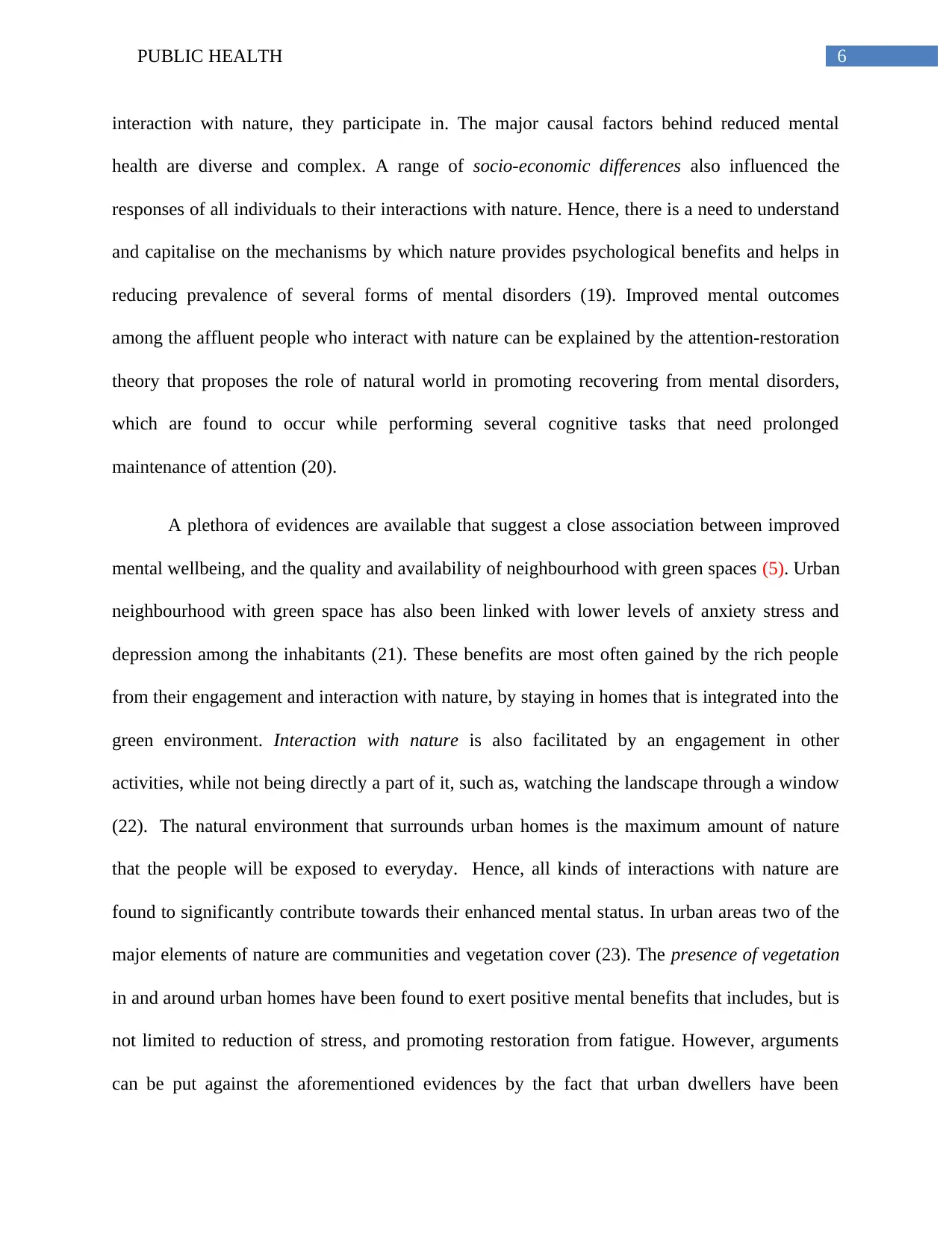
6PUBLIC HEALTH
interaction with nature, they participate in. The major causal factors behind reduced mental
health are diverse and complex. A range of socio-economic differences also influenced the
responses of all individuals to their interactions with nature. Hence, there is a need to understand
and capitalise on the mechanisms by which nature provides psychological benefits and helps in
reducing prevalence of several forms of mental disorders (19). Improved mental outcomes
among the affluent people who interact with nature can be explained by the attention-restoration
theory that proposes the role of natural world in promoting recovering from mental disorders,
which are found to occur while performing several cognitive tasks that need prolonged
maintenance of attention (20).
A plethora of evidences are available that suggest a close association between improved
mental wellbeing, and the quality and availability of neighbourhood with green spaces (5). Urban
neighbourhood with green space has also been linked with lower levels of anxiety stress and
depression among the inhabitants (21). These benefits are most often gained by the rich people
from their engagement and interaction with nature, by staying in homes that is integrated into the
green environment. Interaction with nature is also facilitated by an engagement in other
activities, while not being directly a part of it, such as, watching the landscape through a window
(22). The natural environment that surrounds urban homes is the maximum amount of nature
that the people will be exposed to everyday. Hence, all kinds of interactions with nature are
found to significantly contribute towards their enhanced mental status. In urban areas two of the
major elements of nature are communities and vegetation cover (23). The presence of vegetation
in and around urban homes have been found to exert positive mental benefits that includes, but is
not limited to reduction of stress, and promoting restoration from fatigue. However, arguments
can be put against the aforementioned evidences by the fact that urban dwellers have been
interaction with nature, they participate in. The major causal factors behind reduced mental
health are diverse and complex. A range of socio-economic differences also influenced the
responses of all individuals to their interactions with nature. Hence, there is a need to understand
and capitalise on the mechanisms by which nature provides psychological benefits and helps in
reducing prevalence of several forms of mental disorders (19). Improved mental outcomes
among the affluent people who interact with nature can be explained by the attention-restoration
theory that proposes the role of natural world in promoting recovering from mental disorders,
which are found to occur while performing several cognitive tasks that need prolonged
maintenance of attention (20).
A plethora of evidences are available that suggest a close association between improved
mental wellbeing, and the quality and availability of neighbourhood with green spaces (5). Urban
neighbourhood with green space has also been linked with lower levels of anxiety stress and
depression among the inhabitants (21). These benefits are most often gained by the rich people
from their engagement and interaction with nature, by staying in homes that is integrated into the
green environment. Interaction with nature is also facilitated by an engagement in other
activities, while not being directly a part of it, such as, watching the landscape through a window
(22). The natural environment that surrounds urban homes is the maximum amount of nature
that the people will be exposed to everyday. Hence, all kinds of interactions with nature are
found to significantly contribute towards their enhanced mental status. In urban areas two of the
major elements of nature are communities and vegetation cover (23). The presence of vegetation
in and around urban homes have been found to exert positive mental benefits that includes, but is
not limited to reduction of stress, and promoting restoration from fatigue. However, arguments
can be put against the aforementioned evidences by the fact that urban dwellers have been
Paraphrase This Document
Need a fresh take? Get an instant paraphrase of this document with our AI Paraphraser
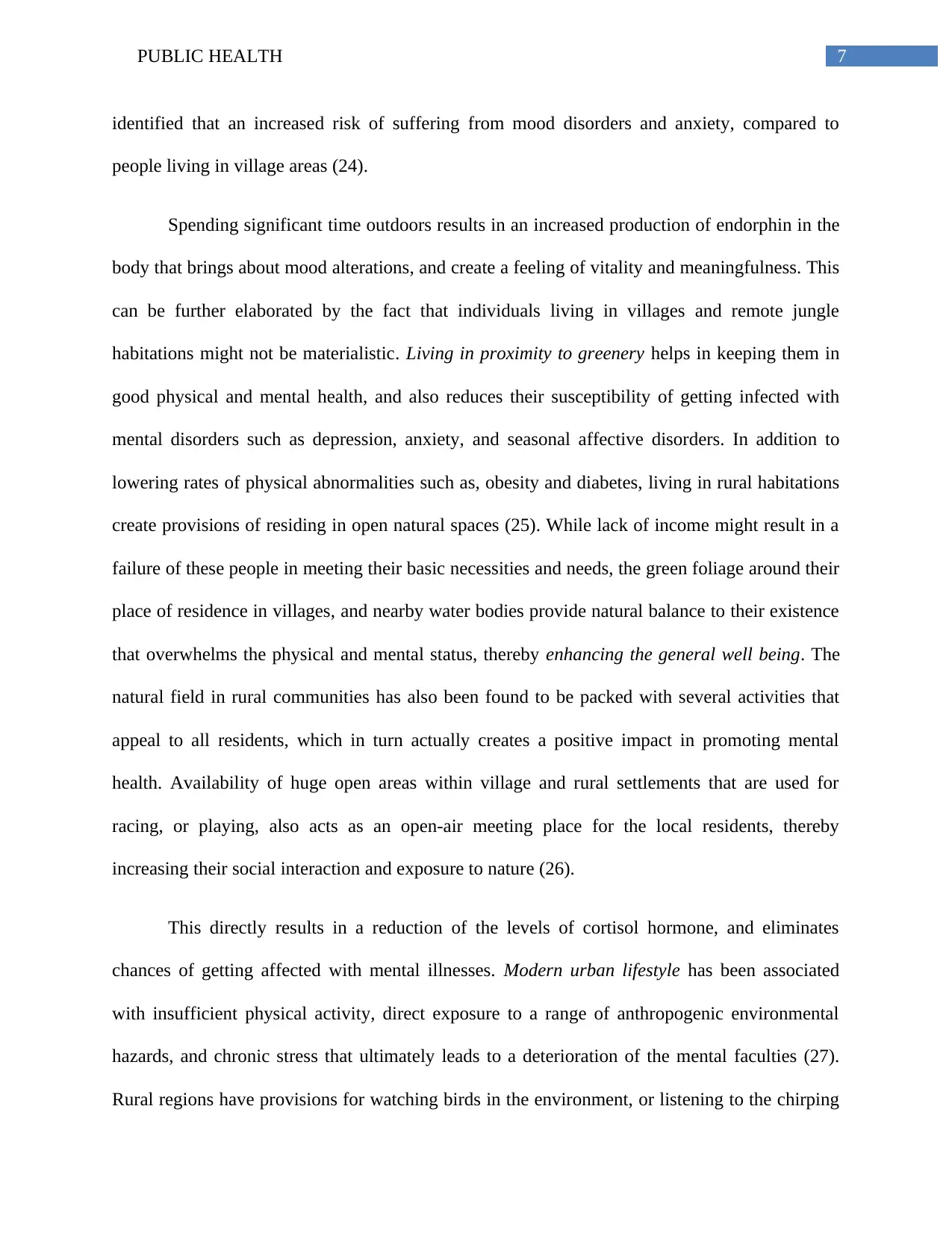
7PUBLIC HEALTH
identified that an increased risk of suffering from mood disorders and anxiety, compared to
people living in village areas (24).
Spending significant time outdoors results in an increased production of endorphin in the
body that brings about mood alterations, and create a feeling of vitality and meaningfulness. This
can be further elaborated by the fact that individuals living in villages and remote jungle
habitations might not be materialistic. Living in proximity to greenery helps in keeping them in
good physical and mental health, and also reduces their susceptibility of getting infected with
mental disorders such as depression, anxiety, and seasonal affective disorders. In addition to
lowering rates of physical abnormalities such as, obesity and diabetes, living in rural habitations
create provisions of residing in open natural spaces (25). While lack of income might result in a
failure of these people in meeting their basic necessities and needs, the green foliage around their
place of residence in villages, and nearby water bodies provide natural balance to their existence
that overwhelms the physical and mental status, thereby enhancing the general well being. The
natural field in rural communities has also been found to be packed with several activities that
appeal to all residents, which in turn actually creates a positive impact in promoting mental
health. Availability of huge open areas within village and rural settlements that are used for
racing, or playing, also acts as an open-air meeting place for the local residents, thereby
increasing their social interaction and exposure to nature (26).
This directly results in a reduction of the levels of cortisol hormone, and eliminates
chances of getting affected with mental illnesses. Modern urban lifestyle has been associated
with insufficient physical activity, direct exposure to a range of anthropogenic environmental
hazards, and chronic stress that ultimately leads to a deterioration of the mental faculties (27).
Rural regions have provisions for watching birds in the environment, or listening to the chirping
identified that an increased risk of suffering from mood disorders and anxiety, compared to
people living in village areas (24).
Spending significant time outdoors results in an increased production of endorphin in the
body that brings about mood alterations, and create a feeling of vitality and meaningfulness. This
can be further elaborated by the fact that individuals living in villages and remote jungle
habitations might not be materialistic. Living in proximity to greenery helps in keeping them in
good physical and mental health, and also reduces their susceptibility of getting infected with
mental disorders such as depression, anxiety, and seasonal affective disorders. In addition to
lowering rates of physical abnormalities such as, obesity and diabetes, living in rural habitations
create provisions of residing in open natural spaces (25). While lack of income might result in a
failure of these people in meeting their basic necessities and needs, the green foliage around their
place of residence in villages, and nearby water bodies provide natural balance to their existence
that overwhelms the physical and mental status, thereby enhancing the general well being. The
natural field in rural communities has also been found to be packed with several activities that
appeal to all residents, which in turn actually creates a positive impact in promoting mental
health. Availability of huge open areas within village and rural settlements that are used for
racing, or playing, also acts as an open-air meeting place for the local residents, thereby
increasing their social interaction and exposure to nature (26).
This directly results in a reduction of the levels of cortisol hormone, and eliminates
chances of getting affected with mental illnesses. Modern urban lifestyle has been associated
with insufficient physical activity, direct exposure to a range of anthropogenic environmental
hazards, and chronic stress that ultimately leads to a deterioration of the mental faculties (27).
Rural regions have provisions for watching birds in the environment, or listening to the chirping
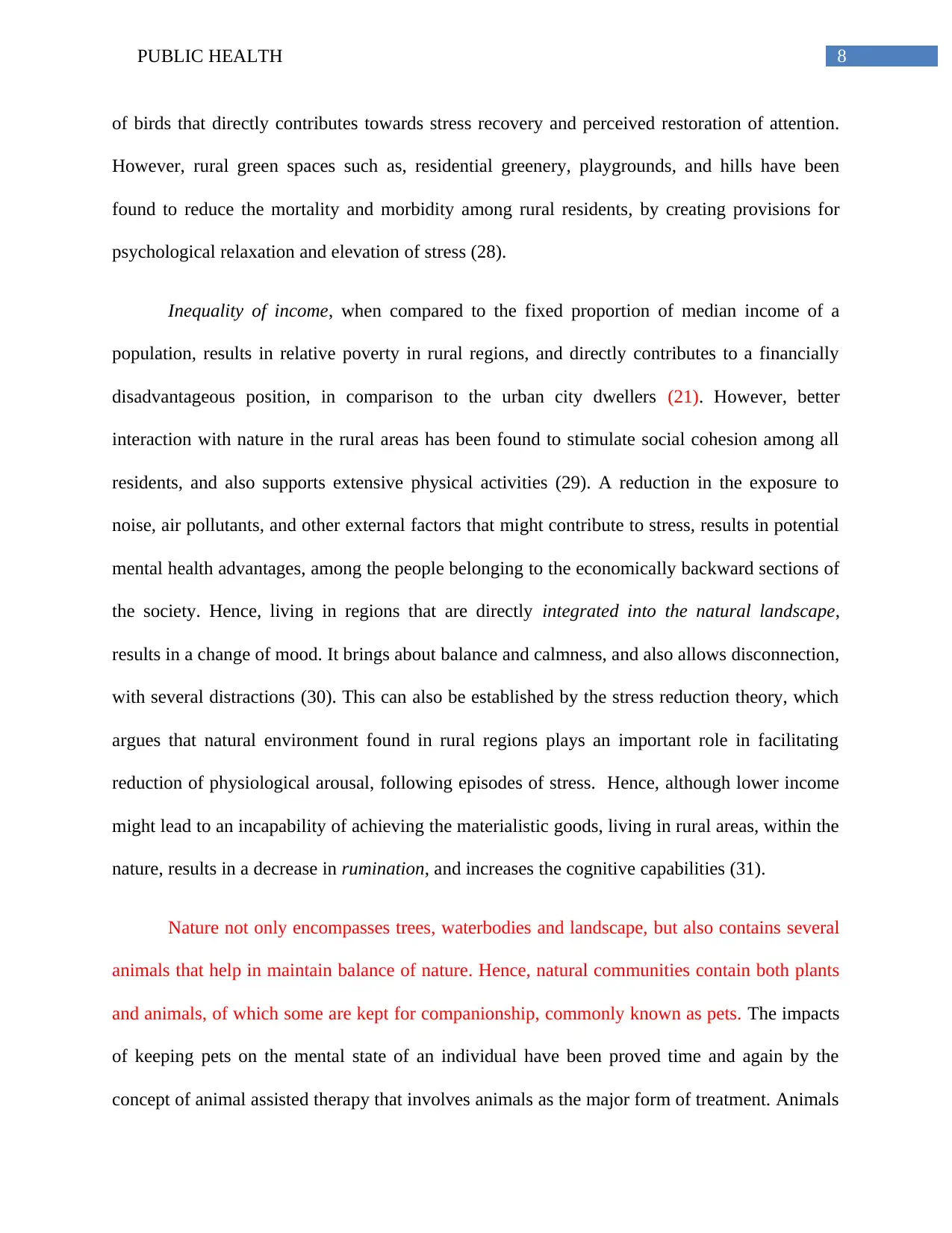
8PUBLIC HEALTH
of birds that directly contributes towards stress recovery and perceived restoration of attention.
However, rural green spaces such as, residential greenery, playgrounds, and hills have been
found to reduce the mortality and morbidity among rural residents, by creating provisions for
psychological relaxation and elevation of stress (28).
Inequality of income, when compared to the fixed proportion of median income of a
population, results in relative poverty in rural regions, and directly contributes to a financially
disadvantageous position, in comparison to the urban city dwellers (21). However, better
interaction with nature in the rural areas has been found to stimulate social cohesion among all
residents, and also supports extensive physical activities (29). A reduction in the exposure to
noise, air pollutants, and other external factors that might contribute to stress, results in potential
mental health advantages, among the people belonging to the economically backward sections of
the society. Hence, living in regions that are directly integrated into the natural landscape,
results in a change of mood. It brings about balance and calmness, and also allows disconnection,
with several distractions (30). This can also be established by the stress reduction theory, which
argues that natural environment found in rural regions plays an important role in facilitating
reduction of physiological arousal, following episodes of stress. Hence, although lower income
might lead to an incapability of achieving the materialistic goods, living in rural areas, within the
nature, results in a decrease in rumination, and increases the cognitive capabilities (31).
Nature not only encompasses trees, waterbodies and landscape, but also contains several
animals that help in maintain balance of nature. Hence, natural communities contain both plants
and animals, of which some are kept for companionship, commonly known as pets. The impacts
of keeping pets on the mental state of an individual have been proved time and again by the
concept of animal assisted therapy that involves animals as the major form of treatment. Animals
of birds that directly contributes towards stress recovery and perceived restoration of attention.
However, rural green spaces such as, residential greenery, playgrounds, and hills have been
found to reduce the mortality and morbidity among rural residents, by creating provisions for
psychological relaxation and elevation of stress (28).
Inequality of income, when compared to the fixed proportion of median income of a
population, results in relative poverty in rural regions, and directly contributes to a financially
disadvantageous position, in comparison to the urban city dwellers (21). However, better
interaction with nature in the rural areas has been found to stimulate social cohesion among all
residents, and also supports extensive physical activities (29). A reduction in the exposure to
noise, air pollutants, and other external factors that might contribute to stress, results in potential
mental health advantages, among the people belonging to the economically backward sections of
the society. Hence, living in regions that are directly integrated into the natural landscape,
results in a change of mood. It brings about balance and calmness, and also allows disconnection,
with several distractions (30). This can also be established by the stress reduction theory, which
argues that natural environment found in rural regions plays an important role in facilitating
reduction of physiological arousal, following episodes of stress. Hence, although lower income
might lead to an incapability of achieving the materialistic goods, living in rural areas, within the
nature, results in a decrease in rumination, and increases the cognitive capabilities (31).
Nature not only encompasses trees, waterbodies and landscape, but also contains several
animals that help in maintain balance of nature. Hence, natural communities contain both plants
and animals, of which some are kept for companionship, commonly known as pets. The impacts
of keeping pets on the mental state of an individual have been proved time and again by the
concept of animal assisted therapy that involves animals as the major form of treatment. Animals
⊘ This is a preview!⊘
Do you want full access?
Subscribe today to unlock all pages.

Trusted by 1+ million students worldwide
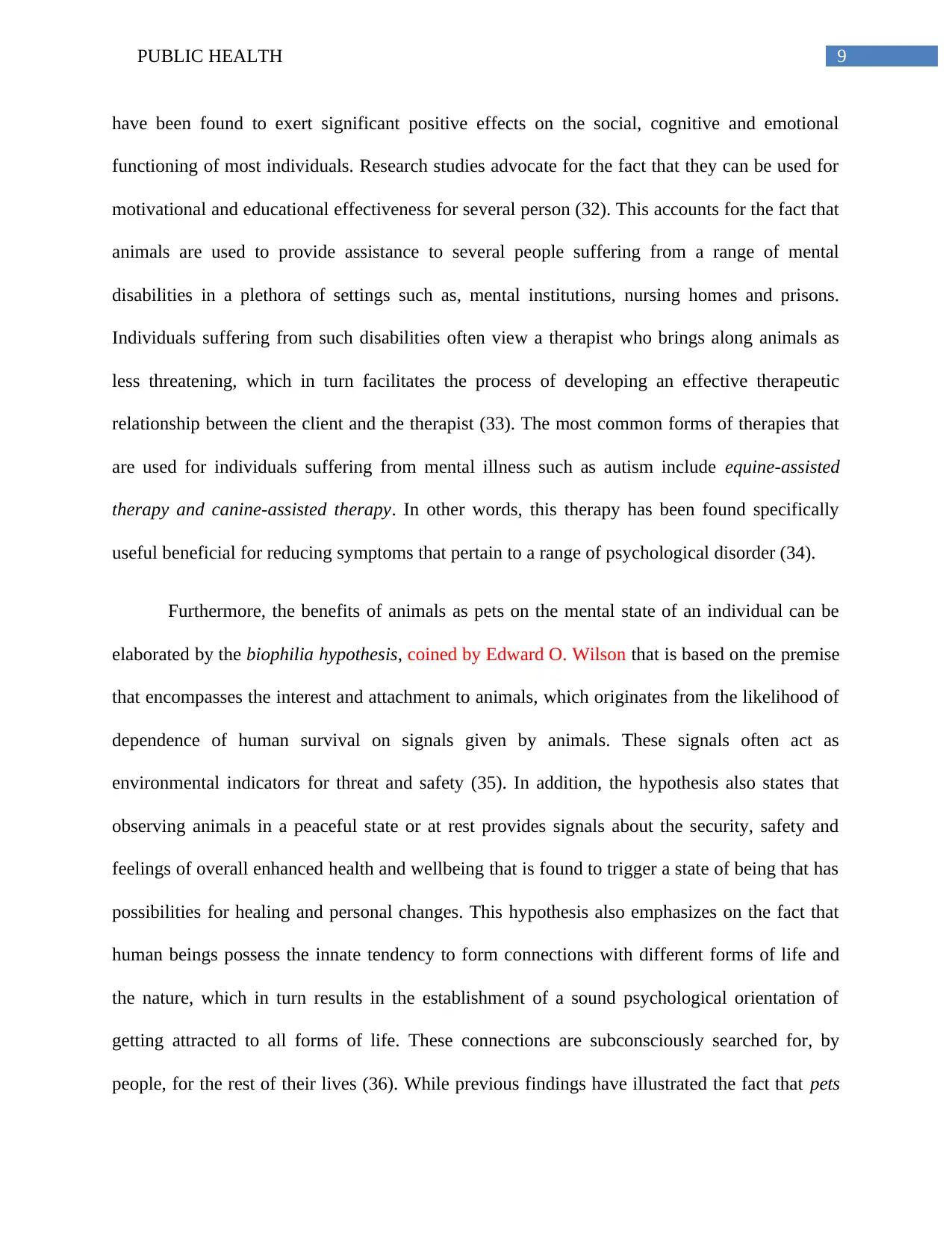
9PUBLIC HEALTH
have been found to exert significant positive effects on the social, cognitive and emotional
functioning of most individuals. Research studies advocate for the fact that they can be used for
motivational and educational effectiveness for several person (32). This accounts for the fact that
animals are used to provide assistance to several people suffering from a range of mental
disabilities in a plethora of settings such as, mental institutions, nursing homes and prisons.
Individuals suffering from such disabilities often view a therapist who brings along animals as
less threatening, which in turn facilitates the process of developing an effective therapeutic
relationship between the client and the therapist (33). The most common forms of therapies that
are used for individuals suffering from mental illness such as autism include equine-assisted
therapy and canine-assisted therapy. In other words, this therapy has been found specifically
useful beneficial for reducing symptoms that pertain to a range of psychological disorder (34).
Furthermore, the benefits of animals as pets on the mental state of an individual can be
elaborated by the biophilia hypothesis, coined by Edward O. Wilson that is based on the premise
that encompasses the interest and attachment to animals, which originates from the likelihood of
dependence of human survival on signals given by animals. These signals often act as
environmental indicators for threat and safety (35). In addition, the hypothesis also states that
observing animals in a peaceful state or at rest provides signals about the security, safety and
feelings of overall enhanced health and wellbeing that is found to trigger a state of being that has
possibilities for healing and personal changes. This hypothesis also emphasizes on the fact that
human beings possess the innate tendency to form connections with different forms of life and
the nature, which in turn results in the establishment of a sound psychological orientation of
getting attracted to all forms of life. These connections are subconsciously searched for, by
people, for the rest of their lives (36). While previous findings have illustrated the fact that pets
have been found to exert significant positive effects on the social, cognitive and emotional
functioning of most individuals. Research studies advocate for the fact that they can be used for
motivational and educational effectiveness for several person (32). This accounts for the fact that
animals are used to provide assistance to several people suffering from a range of mental
disabilities in a plethora of settings such as, mental institutions, nursing homes and prisons.
Individuals suffering from such disabilities often view a therapist who brings along animals as
less threatening, which in turn facilitates the process of developing an effective therapeutic
relationship between the client and the therapist (33). The most common forms of therapies that
are used for individuals suffering from mental illness such as autism include equine-assisted
therapy and canine-assisted therapy. In other words, this therapy has been found specifically
useful beneficial for reducing symptoms that pertain to a range of psychological disorder (34).
Furthermore, the benefits of animals as pets on the mental state of an individual can be
elaborated by the biophilia hypothesis, coined by Edward O. Wilson that is based on the premise
that encompasses the interest and attachment to animals, which originates from the likelihood of
dependence of human survival on signals given by animals. These signals often act as
environmental indicators for threat and safety (35). In addition, the hypothesis also states that
observing animals in a peaceful state or at rest provides signals about the security, safety and
feelings of overall enhanced health and wellbeing that is found to trigger a state of being that has
possibilities for healing and personal changes. This hypothesis also emphasizes on the fact that
human beings possess the innate tendency to form connections with different forms of life and
the nature, which in turn results in the establishment of a sound psychological orientation of
getting attracted to all forms of life. These connections are subconsciously searched for, by
people, for the rest of their lives (36). While previous findings have illustrated the fact that pets
Paraphrase This Document
Need a fresh take? Get an instant paraphrase of this document with our AI Paraphraser
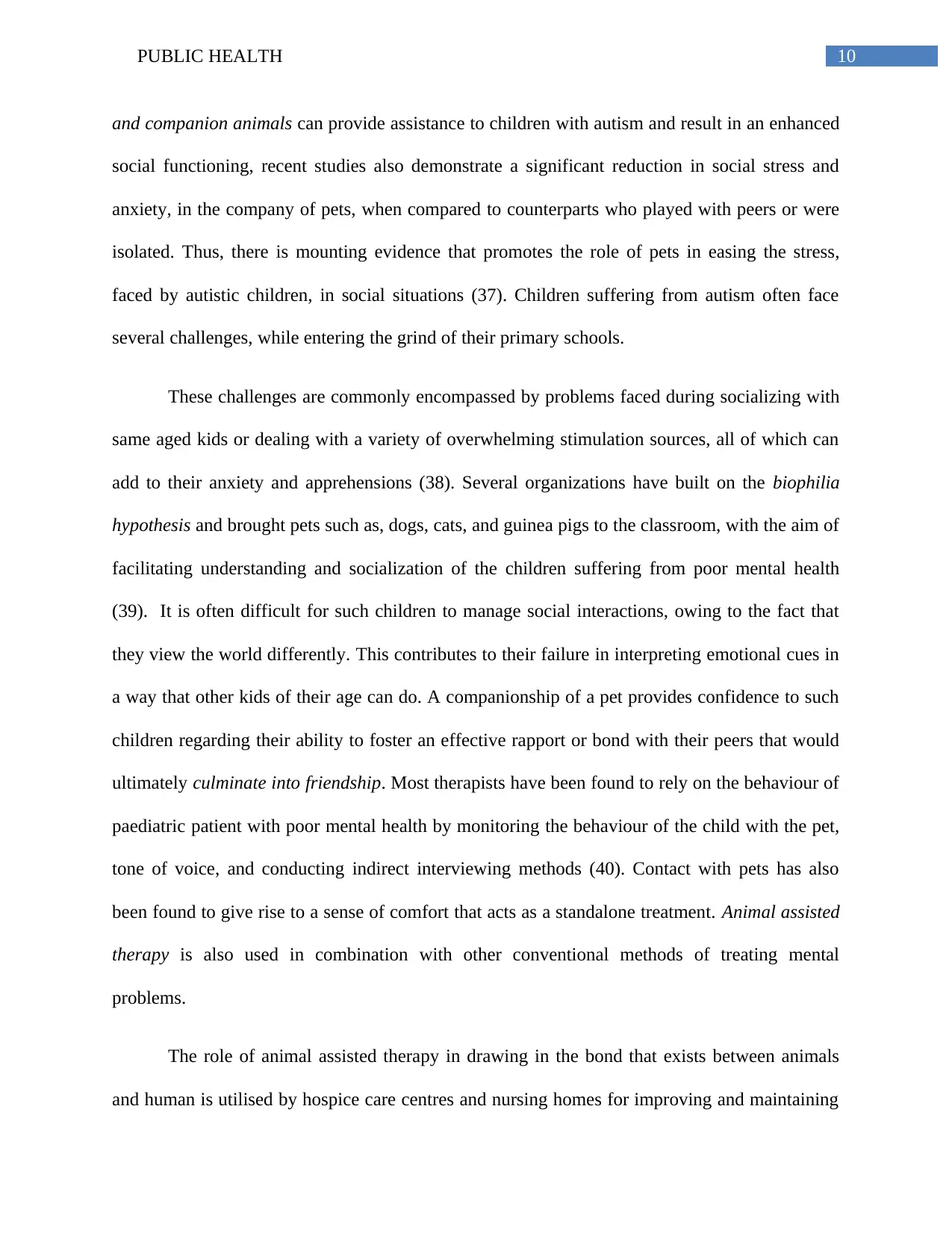
10PUBLIC HEALTH
and companion animals can provide assistance to children with autism and result in an enhanced
social functioning, recent studies also demonstrate a significant reduction in social stress and
anxiety, in the company of pets, when compared to counterparts who played with peers or were
isolated. Thus, there is mounting evidence that promotes the role of pets in easing the stress,
faced by autistic children, in social situations (37). Children suffering from autism often face
several challenges, while entering the grind of their primary schools.
These challenges are commonly encompassed by problems faced during socializing with
same aged kids or dealing with a variety of overwhelming stimulation sources, all of which can
add to their anxiety and apprehensions (38). Several organizations have built on the biophilia
hypothesis and brought pets such as, dogs, cats, and guinea pigs to the classroom, with the aim of
facilitating understanding and socialization of the children suffering from poor mental health
(39). It is often difficult for such children to manage social interactions, owing to the fact that
they view the world differently. This contributes to their failure in interpreting emotional cues in
a way that other kids of their age can do. A companionship of a pet provides confidence to such
children regarding their ability to foster an effective rapport or bond with their peers that would
ultimately culminate into friendship. Most therapists have been found to rely on the behaviour of
paediatric patient with poor mental health by monitoring the behaviour of the child with the pet,
tone of voice, and conducting indirect interviewing methods (40). Contact with pets has also
been found to give rise to a sense of comfort that acts as a standalone treatment. Animal assisted
therapy is also used in combination with other conventional methods of treating mental
problems.
The role of animal assisted therapy in drawing in the bond that exists between animals
and human is utilised by hospice care centres and nursing homes for improving and maintaining
and companion animals can provide assistance to children with autism and result in an enhanced
social functioning, recent studies also demonstrate a significant reduction in social stress and
anxiety, in the company of pets, when compared to counterparts who played with peers or were
isolated. Thus, there is mounting evidence that promotes the role of pets in easing the stress,
faced by autistic children, in social situations (37). Children suffering from autism often face
several challenges, while entering the grind of their primary schools.
These challenges are commonly encompassed by problems faced during socializing with
same aged kids or dealing with a variety of overwhelming stimulation sources, all of which can
add to their anxiety and apprehensions (38). Several organizations have built on the biophilia
hypothesis and brought pets such as, dogs, cats, and guinea pigs to the classroom, with the aim of
facilitating understanding and socialization of the children suffering from poor mental health
(39). It is often difficult for such children to manage social interactions, owing to the fact that
they view the world differently. This contributes to their failure in interpreting emotional cues in
a way that other kids of their age can do. A companionship of a pet provides confidence to such
children regarding their ability to foster an effective rapport or bond with their peers that would
ultimately culminate into friendship. Most therapists have been found to rely on the behaviour of
paediatric patient with poor mental health by monitoring the behaviour of the child with the pet,
tone of voice, and conducting indirect interviewing methods (40). Contact with pets has also
been found to give rise to a sense of comfort that acts as a standalone treatment. Animal assisted
therapy is also used in combination with other conventional methods of treating mental
problems.
The role of animal assisted therapy in drawing in the bond that exists between animals
and human is utilised by hospice care centres and nursing homes for improving and maintaining
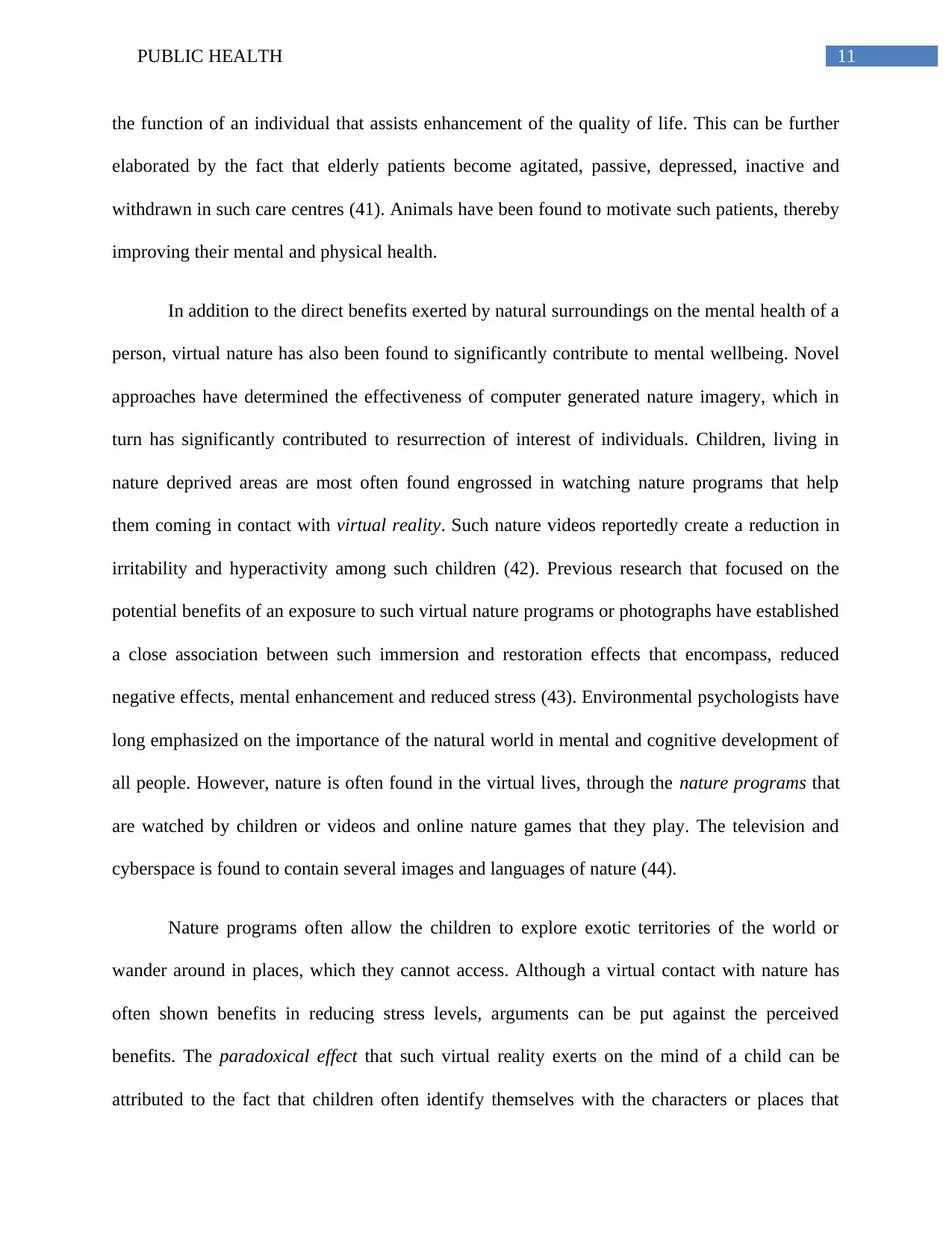
11PUBLIC HEALTH
the function of an individual that assists enhancement of the quality of life. This can be further
elaborated by the fact that elderly patients become agitated, passive, depressed, inactive and
withdrawn in such care centres (41). Animals have been found to motivate such patients, thereby
improving their mental and physical health.
In addition to the direct benefits exerted by natural surroundings on the mental health of a
person, virtual nature has also been found to significantly contribute to mental wellbeing. Novel
approaches have determined the effectiveness of computer generated nature imagery, which in
turn has significantly contributed to resurrection of interest of individuals. Children, living in
nature deprived areas are most often found engrossed in watching nature programs that help
them coming in contact with virtual reality. Such nature videos reportedly create a reduction in
irritability and hyperactivity among such children (42). Previous research that focused on the
potential benefits of an exposure to such virtual nature programs or photographs have established
a close association between such immersion and restoration effects that encompass, reduced
negative effects, mental enhancement and reduced stress (43). Environmental psychologists have
long emphasized on the importance of the natural world in mental and cognitive development of
all people. However, nature is often found in the virtual lives, through the nature programs that
are watched by children or videos and online nature games that they play. The television and
cyberspace is found to contain several images and languages of nature (44).
Nature programs often allow the children to explore exotic territories of the world or
wander around in places, which they cannot access. Although a virtual contact with nature has
often shown benefits in reducing stress levels, arguments can be put against the perceived
benefits. The paradoxical effect that such virtual reality exerts on the mind of a child can be
attributed to the fact that children often identify themselves with the characters or places that
the function of an individual that assists enhancement of the quality of life. This can be further
elaborated by the fact that elderly patients become agitated, passive, depressed, inactive and
withdrawn in such care centres (41). Animals have been found to motivate such patients, thereby
improving their mental and physical health.
In addition to the direct benefits exerted by natural surroundings on the mental health of a
person, virtual nature has also been found to significantly contribute to mental wellbeing. Novel
approaches have determined the effectiveness of computer generated nature imagery, which in
turn has significantly contributed to resurrection of interest of individuals. Children, living in
nature deprived areas are most often found engrossed in watching nature programs that help
them coming in contact with virtual reality. Such nature videos reportedly create a reduction in
irritability and hyperactivity among such children (42). Previous research that focused on the
potential benefits of an exposure to such virtual nature programs or photographs have established
a close association between such immersion and restoration effects that encompass, reduced
negative effects, mental enhancement and reduced stress (43). Environmental psychologists have
long emphasized on the importance of the natural world in mental and cognitive development of
all people. However, nature is often found in the virtual lives, through the nature programs that
are watched by children or videos and online nature games that they play. The television and
cyberspace is found to contain several images and languages of nature (44).
Nature programs often allow the children to explore exotic territories of the world or
wander around in places, which they cannot access. Although a virtual contact with nature has
often shown benefits in reducing stress levels, arguments can be put against the perceived
benefits. The paradoxical effect that such virtual reality exerts on the mind of a child can be
attributed to the fact that children often identify themselves with the characters or places that
⊘ This is a preview!⊘
Do you want full access?
Subscribe today to unlock all pages.

Trusted by 1+ million students worldwide
1 out of 20
Related Documents
Your All-in-One AI-Powered Toolkit for Academic Success.
+13062052269
info@desklib.com
Available 24*7 on WhatsApp / Email
![[object Object]](/_next/static/media/star-bottom.7253800d.svg)
Unlock your academic potential
Copyright © 2020–2025 A2Z Services. All Rights Reserved. Developed and managed by ZUCOL.




![Coursework: Mental Health and Wellbeing of Older People - [University]](/_next/image/?url=https%3A%2F%2Fdesklib.com%2Fmedia%2Fimages%2Fyr%2F3c92269340094292bd18c0d2d99c9706.jpg&w=256&q=75)
